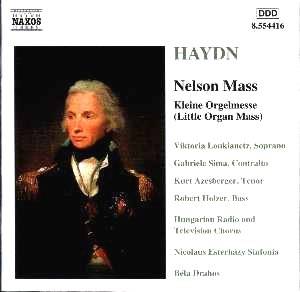Franz Joseph HAYDN (1732 - 1809)
Missa in Anguistiis "Nelson Mass" Hob.XXXII:11 39'44"
Missa brevis Sancti Joannis de Deo "Kleine Oregelmesse". Hob
XXII:7 17'38"
 Viktoria Loukianetz (sop);
Gabriele Sime (contralto); Kurt Azesberger (ten); Robert Holzer (Bass): Hungarian
Radio &Television Chorus Nicolaus Esterházy Sinfonia Béla
Drahos
Viktoria Loukianetz (sop);
Gabriele Sime (contralto); Kurt Azesberger (ten); Robert Holzer (Bass): Hungarian
Radio &Television Chorus Nicolaus Esterházy Sinfonia Béla
Drahos
 Recorded Budapest. June 17
- 20 1998 DDD Naxos 8.554416 [57'31"]
Recorded Budapest. June 17
- 20 1998 DDD Naxos 8.554416 [57'31"]

The two settings of the Latin Mass that make up this Naxos CD that uses entirely
Eastern European performers are from different periods of Haydn's working
life. The so-called "Nelson" Mass dates from 1798 when the composer
was 66 and in the middle of an autumnal creative outburst that included The
Seasons, The Creation and the three great late Masses of which this is one.
The Kleine Orgelmesse dates from some 20 years earlier.
To call it by its Sunday- best name, the Nelson Mass is Missa
in angustiis (Mass in time of anguish). Why Nelson? There are conflicting
tales - one that the work was written at the time of the sea battle at Aboukir
Bay, another that the great Admiral himself attended a performance in 1800.
The name has stuck and that is how we all know it today.
The setting is popular - heard quite regularly both live and in recordings
- and deservedly so. Despite being serious subject matter , this is not a
sombre piece. Haydn's own pleasant and good-natured being comes through into
the music that he scored for strings, timpani, organ and trumpets, with full
chorus and four soloists.
Taken as a whole we have a performance that is good enough to listen to and
enjoy but will not replace established recordings (like an especial long-term
personal favourite on EMI from David Wilcocks). The soloists make a well-matched
team when together, and individually are heard to good advantage (with a
reservation about the vibrato the bass shows in his solo part in the Qui
tollis. The Hungarian Radio Chorus is excellent with a fine balance and
clear diction while the orchestral support is good. In a generally alert
performance, there are times (notably in Qui Tollis and later in the Benedictus)
when the tempo is allowed to drift and the passage becomes a dirge.
The much shorter Kleine Orgelmesse (Little Organ Mass) is a
little charmer. Economically scored for violins and organ, soprano soloist
(who is heard only in the penultimate Benedictus) and choir, its six
sections last just over seventeen minutes. The opening Kyrie - an
adagio - is followed by the merest snatch of plainchant to start the lively
Gloria. The Credo with some fine sectional singing from the
choir has an interpolated slow middle section, leading to the contrapuntal
Sanctus. The longest section of the work is the Benedictus at just
over six minutes. With a soaring soprano line, delightful support from the
chamber organ and restrained strings with a final entry from the Chorus at
Hosanna in excelsis it is an extract that could well find favour in
a "Best of" CD selection. The final Agnus Dei dies away to close this
most captivating of works. Beautifully sung throughout.
Decently recorded (being Naxos it is a new recording, of course), if you
know the works on the disc you won't be let down, if you don't then they
are well worth investigating.
Reviewer
Harry Downey

